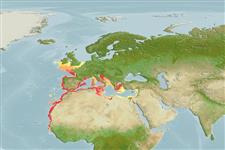Environment: milieu / climate zone / depth range / distribution range
Écologie
marin démersal; profondeur 20 - 250 m (Ref. 4710). Temperate; 53°N - 12°N, 18°W - 36°E
Eastern Atlantic: Portugal southward to Senegal; a single record from southwest of the British Isles; Mediterranean: Spain, Algeria and Turkey.
Taille / Poids / Âge
Maturity: Lm ? range ? - ? cm
Max length : 40.0 cm SL mâle / non sexé; (Ref. 4710)
Description synthétique
Morphologie | Morphométrie
Rayons mous dorsaux (Total): 71-86; Rayons mous anaux: 58 - 68; Vertèbres: 40 - 43. Body oval; upper eye less than its own diameter from dorsal profile of head; anterior nostril on blind side not enlarged; anterior nostril on eyed side with a backward-pointing tube hardly reaching to front border of lower eye; dorsal fin beginning near vertical through front border of upper eye; pectoral fin on eyed side with 6-8 fin rays, on blind side shorter; caudal fin separate from last dorsal and anal fin rays; lateral line supra-temporal branch forming an angular S-shape, the ascending part running upward and backward (Ref. 4710).
Found on mud and sand of the continental shelf, from the shore down to 250 m (Ref. 4710). Feeds on small benthic invertebrates, mainly amphipods and polychaetes (Ref. 4710). Minimum depth range from Ref. 121791.
Life cycle and mating behavior
Maturité | Reproduction | Frai | Œufs | Fécondité | Larves
Desoutter, M., 1994. Révision des genres Microchirus, Dicologlossa et Vanstraelenia (Pleuronectiformes, Soleidae). Cybium 18(3):215-249. (Ref. 35940)
Statut dans la liste rouge de l'IUCN (Ref. 130435)
Menace pour l'homme
Harmless
Utilisations par l'homme
Plus d'informations
Noms communsSynonymesMétabolismePrédateursÉcotoxicologieReproductionMaturitéFraiRassemblement de ponteFéconditéŒufsDéveloppement de l'œuf
RéférencesAquacultureProfil d'aquacultureSouchesGénétiqueElectrophoresesHéritabilitéPathologiesTraitementNutrientsMass conversion
CollaborateursImagesStamps, Coins Misc.SonsCiguateraVitesseType de nageSurface branchialeOtolithesCerveauxVision
Outils
Articles particuliers
Télécharger en XML
Sources Internet
Estimates based on models
Preferred temperature (Ref.
123201): 9.8 - 18.1, mean 13.8 °C (based on 253 cells).
Phylogenetic diversity index (Ref.
82804): PD
50 = 0.5078 [Uniqueness, from 0.5 = low to 2.0 = high].
Bayesian length-weight: a=0.00912 (0.00600 - 0.01386), b=3.06 (2.94 - 3.18), in cm total length, based on LWR estimates for this species & Genus-body shape (Ref.
93245).
Niveau trophique (Ref.
69278): 3.2 ±0.41 se; based on food items.
Generation time: 5.6 ( na - na) years. Estimated as median ln(3)/K based on 2
growth studies.
Résilience (Ref.
120179): Milieu, temps minimum de doublement de population : 1,4 à 4,4 années (Preliminary K or Fecundity.).
Fishing Vulnerability (Ref.
59153): Moderate vulnerability (39 of 100).
Nutrients (Ref.
124155): Calcium = 50.8 [19.5, 139.0] mg/100g; Iron = 0.356 [0.157, 0.750] mg/100g; Protein = 17.9 [16.1, 19.8] %; Omega3 = 0.314 [0.154, 0.621] g/100g; Selenium = 16.8 [8.2, 35.6] μg/100g; VitaminA = 8.03 [1.93, 34.62] μg/100g; Zinc = 0.479 [0.312, 0.715] mg/100g (wet weight); based on
nutrient studies. 